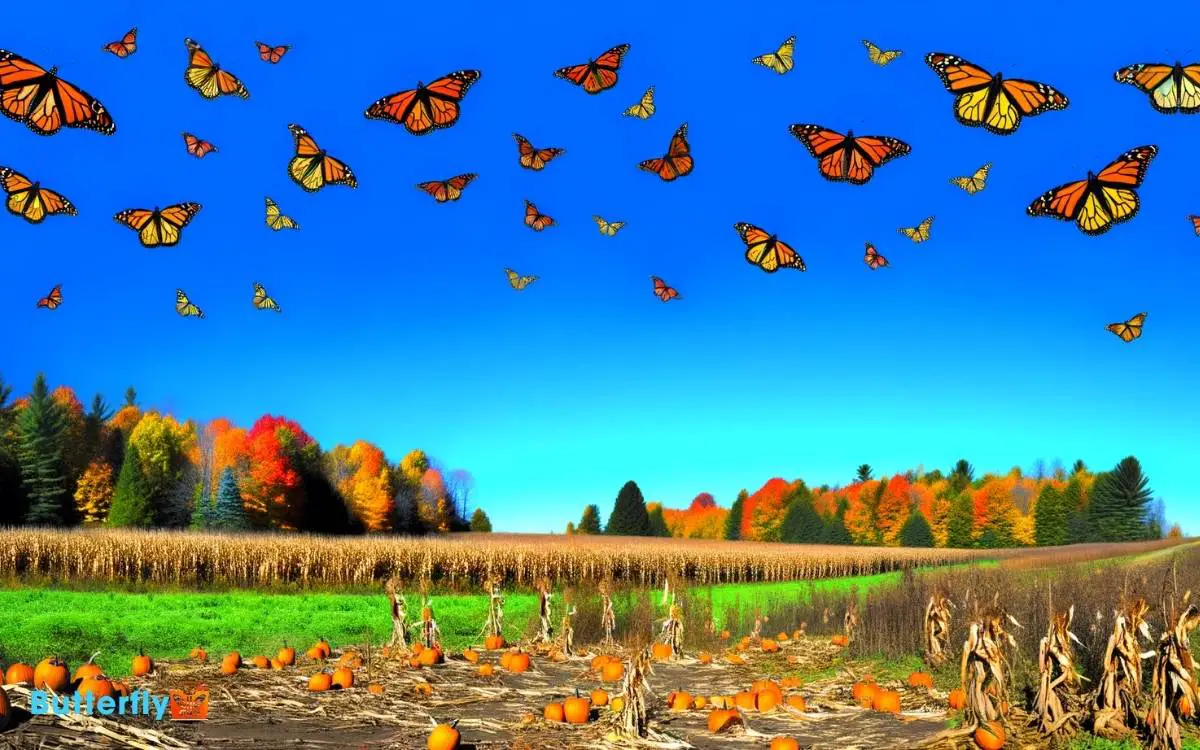Migration of the Monarch Butterfly: Discover the Journey!
Every year, Monarch butterflies undertake an astounding 3,000-mile migration to central Mexico. You’ll observe them starting this journey in late summer, triggered by falling temperatures and shorter daylight hours.
They travel 50-100 miles daily, even reaching altitudes of 10,000 feet. Using solar navigation and magnetic fields, Monarchs maintain an accurate route.
Despite facing severe threats like habitat loss and climate change, they persist, thanks to ecological stopovers filled with flowering plants.
Their navigation involves specialized antennae detecting Earth’s magnetic field, ensuring precision even on overcast days. These details merely scratch the surface of their remarkable migratory phenomena.

Key Takeaways
The Journey Begins
Each year, millions of monarch butterflies commence on an extraordinary migration journey spanning up to 3,000 miles from North America to central Mexico.
You’ll observe that these butterflies, Danaus plexippus, begin their southward trek in late summer and early autumn.
They utilize environmental cues such as temperature drops and diminishing daylight to initiate this arduous voyage. Data suggests that monarchs travel approximately 50-100 miles per day, reaching altitudes of up to 10,000 feet.
Their journey is punctuated by essential stopovers where they refuel on nectar, critical for their survival.
Scientific studies indicate that these stopovers also coincide with specific ecological regions rich in flowering plants, providing the necessary energy reserves for the next leg of their journey.
Navigational Strategies
Despite the challenges of their long migration, monarch butterflies employ a sophisticated combination of solar navigation and magnetic fields to guide their journey.
You’ll find these insects using the sun’s position for orientation, aided by an internal circadian clock to adjust for the changing angle throughout the day. This solar compass is essential, but there’s more.
Monarchs also detect the Earth’s magnetic field using specialized receptors in their antennae. Scientific studies have demonstrated that disrupting these receptors leads to disoriented flight paths.
Intriguingly, monarchs maintain a precise migratory route over 3,000 miles, showcasing their remarkable navigational prowess. Data reveals that even during overcast days, when the sun’s obscured, they rely mainly on geomagnetic cues to stay on course.
Environmental Challenges
Monarch butterflies face numerous environmental challenges, including habitat loss, climate change, and pesticide exposure, which greatly endanger their migratory success.
You’ll notice that urbanization and deforestation reduce the availability of milkweed, the primary food source for their larvae.
Studies reveal that climate change disrupts their migratory timing, leading to mismatches in breeding cycles and food availability.
Additionally, increased temperatures can force monarchs to migrate earlier or later, complicating their survival. Pesticide use, particularly neonicotinoids, affects butterfly mortality rates and reproductive success.
Data indicate a 90% decline in monarch populations over recent decades. By understanding these threats, you can better appreciate the urgency of conservation efforts aimed at preserving these remarkable insects and their migratory phenomenon.
Life Cycle and Stages
Understanding the life cycle and stages of the monarch butterfly provides critical insight into how environmental challenges impact their development and survival.
Monarchs undergo complete metamorphosis, consisting of four distinct stages: egg, larva (caterpillar), pupa (chrysalis), and adult butterfly.
You’ll find that eggs hatch within 3-5 days, releasing larvae that feed on milkweed for 10-14 days. During this period, they undergo five instar stages, growing exponentially. The pupal stage lasts around 10 days, during which the larva transforms into an adult butterfly.
Conservation Efforts
You’re about to explore critical conservation efforts aimed at preserving monarch butterfly populations.
Focus on habitat preservation strategies, understanding threats to their survival, and community involvement initiatives.
Data from recent studies highlight the urgent need for these targeted actions.
Habitat Preservation Strategies
To safeguard the survival of monarch butterflies, conservationists are employing data-driven strategies such as habitat restoration, milkweed planting, and creating protected migration corridors. By restoring native habitats, you help reestablish critical breeding grounds.
Planting milkweed, the monarchs’ primary food source, directly supports their lifecycle. Data from tagging and tracking monarchs reveal key migration routes, allowing you to focus on preserving these crucial corridors.
Implementing these strategies involves precise actions. For instance, you might plant native milkweed species, ensuring they bloom during peak migration periods.
Monitoring butterfly populations through citizen science programs provides essential data, enhancing conservation efforts.
Threats to Survival
Despite concerted conservation efforts, monarch butterflies face significant threats from habitat loss, climate change, and pesticide exposure, all of which severely impact their population numbers.
Deforestation in their overwintering sites in Mexico reduces essential roosting habitats. You’ll find that extreme weather events, intensified by climate change, disrupt their migratory patterns and breeding cycles.
Moreover, increased use of glyphosate-based herbicides in agricultural areas destroys milkweed, the sole food source for monarch larvae. Studies indicate a staggering 80% decline in monarch populations over the past two decades.
Data reveals that even slight temperature increases can shift breeding ranges, leading to mismatches in food availability. Your understanding of these threats underscores the urgency of robust, targeted conservation strategies for monarch survival.
Community Involvement Initiatives
Recognizing these threats, community involvement initiatives have emerged as crucial conservation efforts, focusing on habitat restoration and public education to bolster monarch butterfly populations.
By planting native milkweed and nectar plants, you can create essential waystations for migrating monarchs. Data shows that waystations increase survival rates by providing necessary resources.
Educational programs, both in schools and communities, raise awareness about the monarchs’ plight. By participating in citizen science projects, you can contribute valuable data on migration patterns, aiding researchers in tracking population changes.
Studies indicate that public involvement greatly enhances conservation outcomes. Through these combined efforts, you help to create a sustainable environment that supports the monarchs’ incredible migratory journey. Your actions make a measurable difference.
Global Significance
The migration patterns of the Monarch butterfly hold significant ecological and environmental implications at a global scale, influencing biodiversity and ecosystem health.
You’ll notice that their journey, spanning thousands of miles, plays an essential role in various ecosystems.
Monarch butterflies are key pollinators, contributing to the reproductive success of numerous plant species. Their migration also serves as an indicator of environmental changes and ecosystem integrity.
Consider these impacts:
- Pollination: Monarchs aid in the pollination of milkweed and other plants, vital for maintaining plant biodiversity.
- Food Web: They provide a food source for predators, sustaining the food web.
- Climate Indicators: Migration patterns reflect climate change and habitat health.
- Conservation Awareness: Their plight raises global awareness on conservation efforts.
Understanding these factors helps you appreciate the broader significance of their migration.
Conclusion
As you witness the monarch butterfly’s epic migration, you can’t help but marvel at their navigational prowess and resilience against environmental challenges.
Their journey, akin to a cross-country road trip in a Model T, showcases intricate life stages and underscores urgent conservation needs.
By understanding and supporting these efforts, you contribute to preserving a species with global ecological significance. Together, let’s guarantee monarchs continue their crucial, data-driven odyssey for generations to come.






